This was published 10 months ago
Naomi Campbell: ‘Victim is not in my vocab. I don’t want people to feel sorry for me’
She may have struggled in the past, but the 54-year-old supermodel bristles at any attempt to paint her as an underdog.
By Alice Thomson
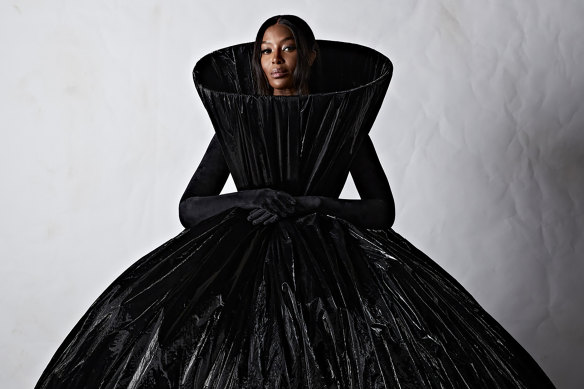
“I’m seen everywhere in a million pictures, but rarely heard.” Credit: Launchmetrics Spotlight
Naomi Campbell is always late. It’s fascinating. She might occasionally think it would be entertaining to arrive early and surprise everyone. But no, her team tells me she will be running at least three hours behind schedule, and she is. At the Dorchester hotel in London, the pianist in the foyer has given up; even the fruit and pastry baskets are wilting. Then suddenly the door opens and the most fabulous cheekbones in the world enter the room followed by a man with a box of tissues.
Campbell, 54, throws herself down into the armchair and starts to sneeze. “I’m so sorry. Thank you so much, thank you,” she says as I hand her some tissues and a glass of water. “I don’t know what’s happened. I never had hay fever before in my life but I feel like I’ve developed it now. Is that possible? My whole nose is itching. Is it very high pollen? Could you recommend something? Help!”
She sounds so contrite, I find myself offering advice. Would she like some antihistamine or steroid drops? I can’t believe I’m handing you drugs, I say.
She laughs, dispelling any last remnants of grandeur. “I’m desperate,” she says. “I don’t have time to be ill.” The catwalk queen goes to inordinate lengths to stay well, including sterilising every corner of her first-class plane seat and wearing a hazmat suit through airports during the pandemic. But perhaps it says more about her professionalism than her paranoia. She knows she can’t be ill when she eventually does arrive — the camera doesn’t like a dripping nose and red eyes. One of the most startlingly beautiful women in the world can’t afford to have a bad day.
This afternoon she is in a full-length black silk sleeveless dress, jewelled kitten heels and what at first I think is a fur coat draped around her shoulders, but is actually a hotel bathrobe trailing the floor. She is wearing no bra and one breast is on show, but she seems entirely comfortable with her astonishingly lithe body, which she stretches out languidly like a cat. “I don’t feel like I’m nude when I’m nude,” she says, “when it is tastefully done.”
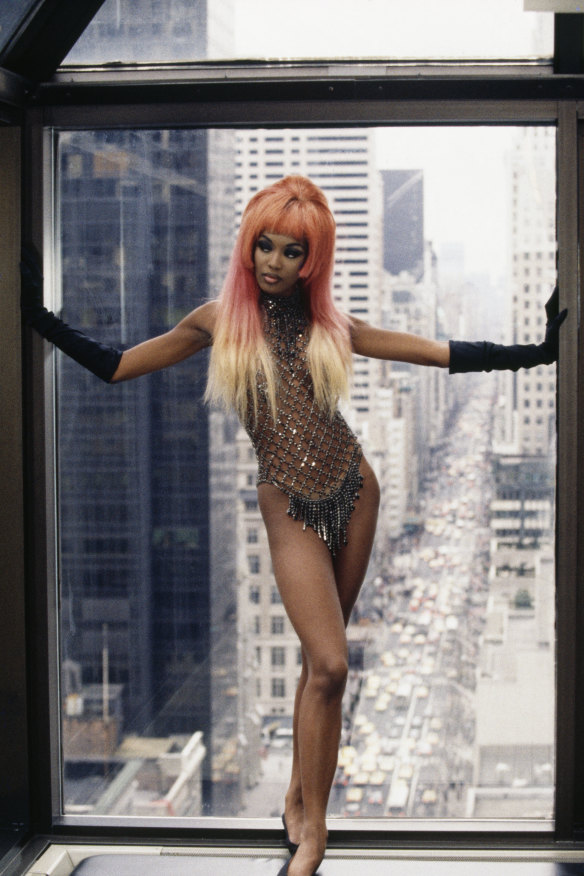
Campbell in a Thierry Mugler dress at a photo shoot in New York, 1991. Credit: Julio Donoso
Supermodel, actor, dancer in George Michael’s Freedom! ’90 video, designer, TV presenter, contributing editor of Vogue, campaigner, novelist (one of her few failures), Campbell was the first great influencer before anyone had heard of the Kardashians, photographed by everyone from Herb Ritts to Terence Donovan and David Bailey. As she once said, “I know my value. If I walk for you, you’ll get your press.”
Her voice is part old-fashioned glamour, part south London drawl, and slow. She ponders every question before she answers. The strangest part of being a supermodel, she says, is that very few people ever hear your voice or learn your views. “I’m seen everywhere in a million pictures, but rarely heard. It’s why Linda [Evangelista], Christy [Turlington], Cindy [Crawford] and I decided to do The Super Models documentary last year (on Apple TV+). We have never had ownership as models of our image, which is really crazy. We only see the photographs when they come out. Models are never in control; they are always being manipulated. We wanted to feel seen, heard and respected and not just a doll.” (Although she does have her own Barbie and Sindy dolls.)
Campbell’s story starts with a father she has still never met and refuses to discuss; her mother, Valerie, a dancer, had Naomi at 17 and was aspirational for her daughter. “But I never thought I would be a star. I went to a theatre school [Italia Conti] – everyone was ambitious and competitive in a good way. My mum was paying for my school and for private tuition so I didn’t want to let her down. She didn’t want me to be a model,” she explains. “She wanted me to study theatre and dance, but it hasn’t all gone to waste.” This is Naomi-style modesty – she knows her worth.
I suspect even if she hadn’t been talent-spotted shopping in Covent Garden, she was going to be discovered somehow. It’s hard to hide those legs. But her mother was still uncomfortable with her daughter being whisked abroad aged 15 to model her first shoot for Elle in New Orleans, clutching only traveller’s cheques. “Do you remember those? She is a very strong woman and comes from a family of strong women – they keep me grounded and had a huge influence on me. My mother worked so I was independent. It’s a great thing if children display that quality, so I don’t worry about working with my own children.” Her baby daughter has already been on the cover of Vogue. “I’m not sure I would let her start working at 15. It’s a ruthless world.”
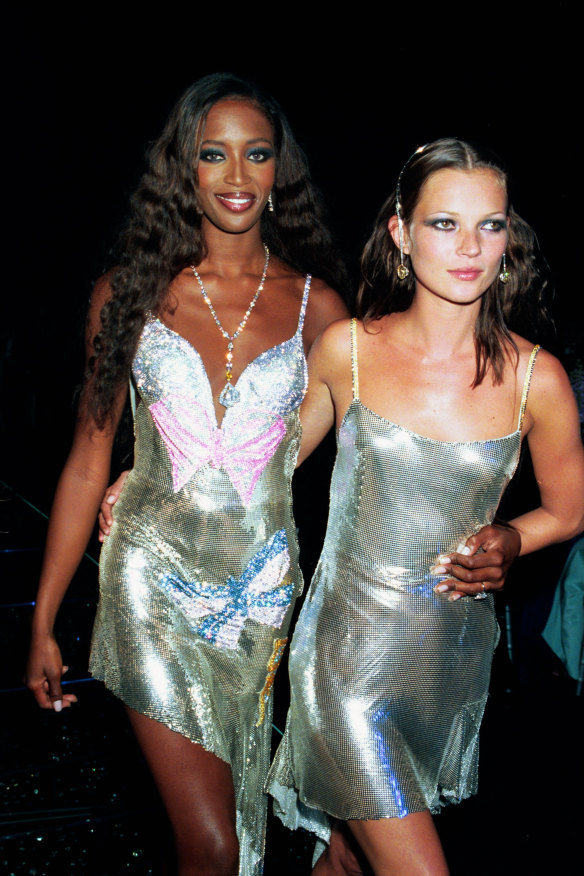
Campbell with fellow model Kate Moss in 1999. Credit: Getty Images
Campbell, who struts the shows with a walk once described as “Get the f--- out of my way”, not only survived but thrived. The original British supermodel, who came of age in the ’90s and epitomised Cool Britannia with Kate Moss, was always more glamour than grunge.
There was a time when the first supermodels were as famous as the Beatles, Linda Evangelista suggests in the documentary, as they linked arms down the catwalk. “I don’t know if it was about power,” she says, momentarily tentative. “At that time there was so much going on and it was so fast-paced, one thing to the next, that I don’t know we had that much time to enjoy what we were doing, honestly. We had fleeting moments – sometimes when designers were being recognised and getting accolades and awards, they would invite us to partake, which was wonderful.” Yet they were criticised for being pushy, aggressive and ambitious in a backlash that started almost before that famous quote about not getting out of bed for less than $10,000. “We made good money, but it was just a headline, because it wasn’t anything like what the fashion industry was making out of us.”
Were they judged harshly partly because they were women? “It could be.” It felt at times that even the fashion world had turned against them for being more than coat hangers. “I have no idea what they thought. I was in this bubble, living my life and getting to the next job. I loved being part of the creation at the beginning and seeing it all come to life. I didn’t feel we had become too spoilt and rich. The industry was still run by men.”
Life might have been easier if Campbell had been more compliant or more of a victim rather than having a tantrum whenever she felt that she was being disrespected, lashing out at police officers at Heathrow and throwing her minuscule frame around. It’s fascinating how much smaller and more vulnerable she is in person. “I’m not a victim. I do not identify with that word. I won’t say I struggled. Everyone’s life has strife in some way, but ‘victim’ is not in my vocab. I don’t want people to feel sorry for me. I want to stay in charge.”
She did, however, struggle to be included as a black model, constantly having to fight at the beginning of her career to be included in shows with her paler contemporaries. “I was lucky I got together with other black models. Being able to speak about how I felt as a black woman and model was very important for me and helped me to share my feelings. I wasn’t alone – that was a huge factor and I hope I help the next generation.”
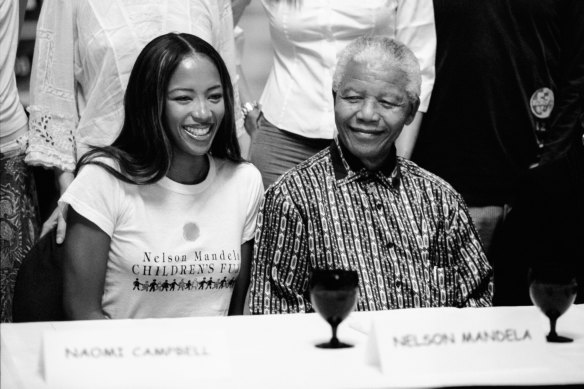
Campbell with Nelson Mandela in 2001.Credit: Sygma via Getty Images
She bristles at any attempt to paint her as an underdog. More often than not, though, she is still the only black woman on the catwalk or at parties. “I’ve been in so many rooms as the only person of colour many times. I would be aware, but I never let it deter me. I learnt to work it to my advantage – it was how I could keep my head up high. When I went to work in New York, I couldn’t even get a cab. Christy would help me, but the crazy thing was the driver was usually black. They worried I’d want to go to Harlem or couldn’t pay. It taught me you can’t assume; assumptions are a really bad mindset.”
This was when she began to get the reputation for being difficult. “Pushing was a way of life as a black woman – when people ask me today why I was so tricky, it was what I had to do. I didn’t have time to mind or be hurt; I quickly needed to find a way to change the dynamic and the easiest way was to make a fuss.”
By 2000, she was on the cover of Time magazine as the face of the new millennium. “I didn’t even know it was the cover. It was a day when I probably had two other shoots and I just remember being told they are doing an article on supermodels and you are wearing this dress and that was it. I didn’t know what they were writing, just that they had some interest in our lives. By that stage, we were seeing what I had for breakfast on the cover of the front pages of the papers in Italy – it was insane.”
Hounded by the paparazzi, she successfully sued The Mirror newspaper when it disclosed details of her leaving a Narcotics Anonymous meeting at the height of her partying. She sounds like she has made her peace with the press. “I managed to have my life. I feel like I can morph – that’s a great word – and be unrecognisable. I go all over the place here, shopping with my mum, films. I am not looking for attention when I’m on my own time. I want to relax and I’m able to go under the radar.”
At the height of the Supers’ powers, she knew she was out of control, addicted to cocaine and alcohol, and entered rehab in 1999. “Drugs, rock’n’roll, it was fun at the time until you realise you cannot let this be who you are and this can’t take over your life. I just felt I didn’t like the way I was becoming and so I decided, ‘I am going to rehab.’ And I loved going to rehab. It was in America.”
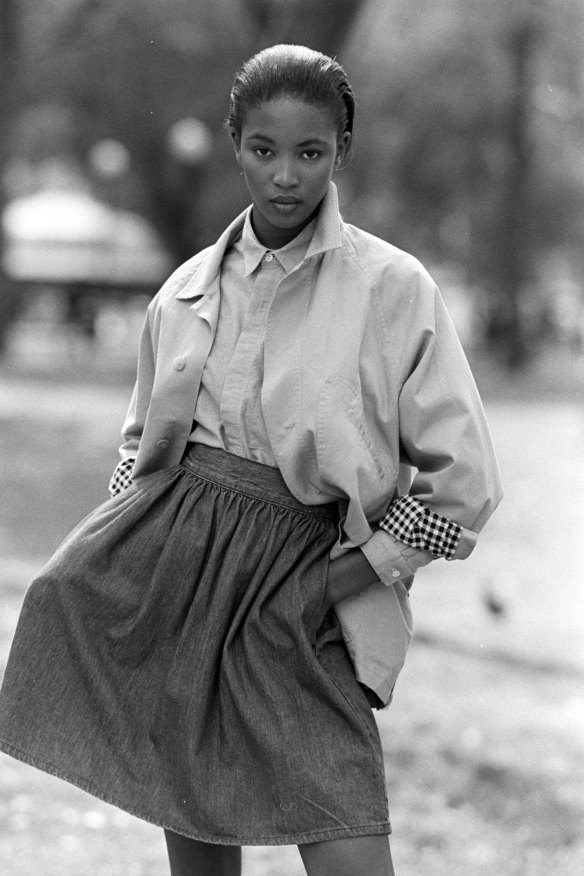
Campbell models for Calvin Klein in 1988.Credit: Penske Media via Getty Images
Was it like a holiday, finally? “Not at all. Every hour there was something and I love discipline and structure as a dancer. That was my early life, so that is what I tend to gravitate towards. I am better with a timetable, so I loved it. I hate free time and having nothing to do.”
Meeting Nelson Mandela when he was released from jail, she says, was another high and she lights a candle for him every day. “I will forever be grateful and blessed that I met such an incredible man. His energy and way of being and demeanour were remarkable and how humble he was, without any anger towards anyone who had done wrong to him. For many reasons, I still have to pinch myself that such a wonderful human being – saint, really – was in my life. He turned it round.”
She now prays most days. She doesn’t strike me as religious. “I was always religious, that was how I was raised. But being in recovery has pushed that forward as well. I leave it up to my higher power.” Giving up smoking has been the hardest battle. “I have finally given up. I admit I have attempted various times. I don’t vape – it would be better to smoke a cigarette and the gesture is just so much classier. I don’t have any vices left – I’m a boring old thing, very dull. I don’t need highs now. I love chocolate and sweets occasionally. I’d have a whole bar of chocolate every night if I could, but I have got to limit myself. It’s all about balance, balance, balance,” she laughs.
She’s also given up the bad behaviour though not being late. Does she now feel it was unfair she was called out more than the other models? “You can say that, but if I did something I copped to it. I went through my lesson of learning and going through life in the public eye.”
As a mother of two small children, Campbell is now more anxious. “My babies are everything to me. It’s made me fear for the future.” Her children were born when she was 51 and 53 and although she’s dated musicians, actors and billionaires, she was never looking for a father, she says – she’s happy being “a single mother of a single mum”. Did she have a surrogate? “I did. I hope for a better world for my children. They are 110 per cent my priority. I have to be there for them on their first day at school.”
She is worried that Gen Z appears to have given up having children and the birth rate is plummeting. “I have heard a lot of young girls saying that it is too expensive to have children and they may not want them, and I have said, ‘You will change your mind. You will want to be a mum.’ I understand economically it is tough. But my mum had nothing and she made it work. It’s worth it. It is so amazing.”
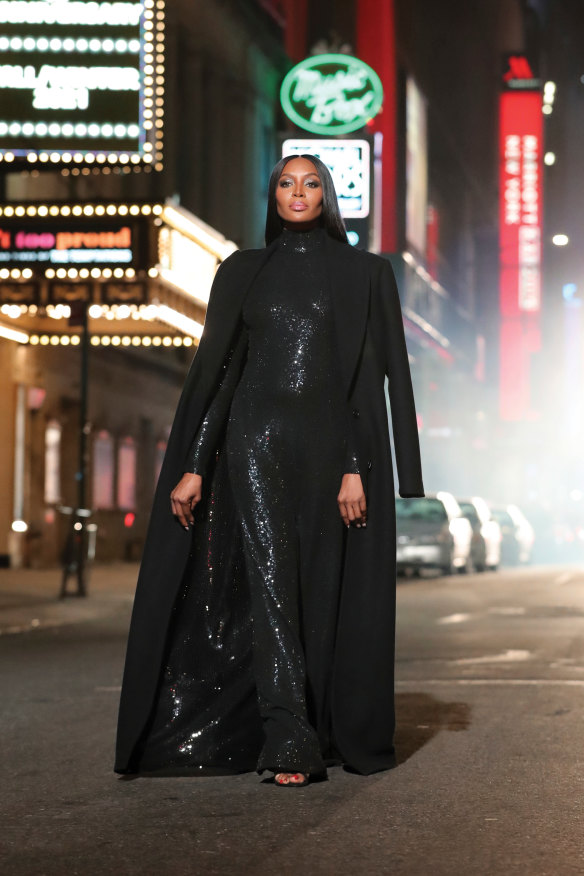
Campbell wears Michael Kors in 2021.Credit: Launchmetrics Spotlight
It feels hard to be Gen Z or even Gen Alpha now. “We have to depend on the younger generation to change this world. I trust my children more than us to do the right thing.”
Look at mental health issues, she says. “It’s great that the young have finally recognised and accepted mental health issues. Young people feel comfortable to come out and share that they have a problem. Before you were considered crazy or self-obsessed if you said, ‘I am going to see a psychologist or psychiatrist or a shrink.’ That is ignorant; there is nothing wrong in that, bettering your quality of life. There is nothing wrong in going to rehab to recover.”
Campbell is happy now to talk about her therapy. “I had therapy back in the day but I feel like being in the recovery program has been a good therapy for me. I never felt alone. I have a great group and we all uplift each other doing conference calls. I can get on that call and trust who is on that call. It’s got me through. It’s all I need now.”
So many of her mentors have died, from Versace to Vivienne Westwood, Alexander McQueen, Mandela and Alaïa, her Papa – often too young. “Grief is not an easy thing. I have realised that part of my going out and numbing my pain was to do with grief. But it wasn’t right for me. Now I have learnt to honour these people in different ways. They are still around in another capacity. I miss them. There is a common denominator in the people I have loved and respected in my life — they had integrity about who they were and carried themselves with dignity and were comfortable in their skins.”
Nelson Mandela told her that she could sleep when she was gone. Although she still dominates the catwalks after nearly 40 years, does she feel a sense of her own mortality? “I just want to do things I love now. There has never been a strategy, though nobody believes that. When I was seven, I did a video with Bob Marley, but I didn’t even know what a superstar was. As a teenager, I thought it was Boy George, never a black girl from south London who wore expensive clothes. It still feels weird being a role model.”
Will she ever retire? “I don’t like that word,” she replies, sounding momentarily like the old petulant Naomi. “But if I don’t want to do it any more, I won’t.”
Get the best of Sunday Life magazine delivered to your inbox every Sunday morning. Sign up here for our free newsletter.